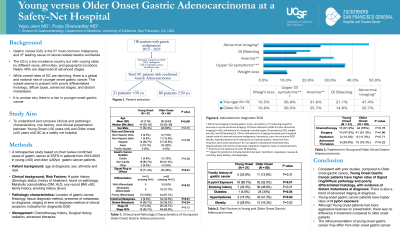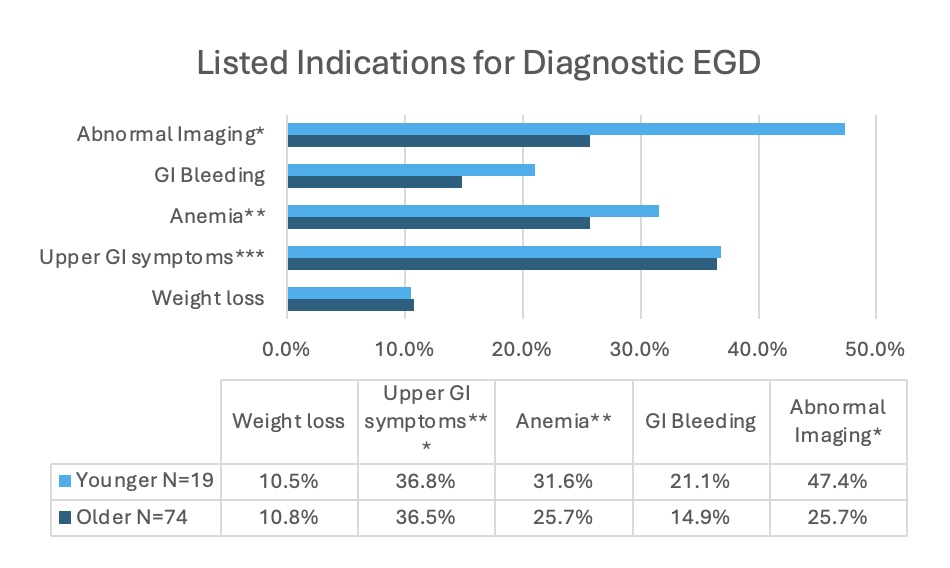Tuesday Poster Session
Category: Stomach
P5058 - Young Versus Older Onset Gastric Adenocarcinoma at a Safety Net Hospital
Tuesday, October 29, 2024
10:30 AM - 4:00 PM ET
Location: Exhibit Hall E

Has Audio
- YJ
Yejoo Jeon, MD
University of California San Francisco
Presenting Author(s)
Yejoo Jeon, MD1, Pooja Dharwadkar, MD2
1University of California San Francisco, San Francisco, CA; 2University of California San Francisco, San Fransisco, CA
Introduction: Gastric cancer is a common cause of cancer-related death around the world, but overall rates are declining in the United States. However, there is a rising incidence of gastric cancer among younger individuals. There is limited understanding as to why this incidence is rising but may be explained by differing exposure to risk factors or tumor biologic factors.
Methods: We completed a retrospective review of gastric adenocarcinoma cases diagnosed or treated at a single safety-net hospital between 2013-2023. We compared risk factors and clinicopathologic characteristics in younger (< 50 years) versus older (≥50 years) individuals.
Results: 101 patients with confirmed gastric adenocarcinoma were included. 21 were young-onset and 80 were older-onset. Mean age was 42 in younger and 65 in older patients. Prior H pylori exposure was significantly higher in young versus older individuals (85.7% vs 52.5%, p =0.01), and older patients had higher rates of metabolic disease such as hyperlipidemia (14.3% younger vs 41.3% p=0.04) and diabetes (4.8% vs 30%, p=0.04). There was no significant difference in incidence by race/ethnicity or sex between groups. More young patients had gastrointestinal bleeding or anemia in the absence of overt GI bleeding as an indication for upper endoscopy, but this difference was not statistically significant. Younger patients were diagnosed at advanced stages with 66.7% presenting with metastatic disease compared to 38.2% of older patients (p=0.04) and had more aggressive pathologic features including signet ring cell or diffuse pathology (71.4% vs 35%, p=0.007) and poorly differentiated adenocarcinoma (100% vs 67.7%, p=0.03). There was no difference in receipt of chemotherapy, surgical, radiation, or advanced treatments between groups.
Discussion: Younger patients present with more advanced and aggressive disease features compared to older patients. H pylori rates are significantly higher in younger suggesting a need for improved testing and treatment of this well-known risk factor.

Note: The table for this abstract can be viewed in the ePoster Gallery section of the ACG 2024 ePoster Site or in The American Journal of Gastroenterology's abstract supplement issue, both of which will be available starting October 27, 2024.
Disclosures:
Yejoo Jeon, MD1, Pooja Dharwadkar, MD2. P5058 - Young Versus Older Onset Gastric Adenocarcinoma at a Safety Net Hospital, ACG 2024 Annual Scientific Meeting Abstracts. Philadelphia, PA: American College of Gastroenterology.
1University of California San Francisco, San Francisco, CA; 2University of California San Francisco, San Fransisco, CA
Introduction: Gastric cancer is a common cause of cancer-related death around the world, but overall rates are declining in the United States. However, there is a rising incidence of gastric cancer among younger individuals. There is limited understanding as to why this incidence is rising but may be explained by differing exposure to risk factors or tumor biologic factors.
Methods: We completed a retrospective review of gastric adenocarcinoma cases diagnosed or treated at a single safety-net hospital between 2013-2023. We compared risk factors and clinicopathologic characteristics in younger (< 50 years) versus older (≥50 years) individuals.
Results: 101 patients with confirmed gastric adenocarcinoma were included. 21 were young-onset and 80 were older-onset. Mean age was 42 in younger and 65 in older patients. Prior H pylori exposure was significantly higher in young versus older individuals (85.7% vs 52.5%, p =0.01), and older patients had higher rates of metabolic disease such as hyperlipidemia (14.3% younger vs 41.3% p=0.04) and diabetes (4.8% vs 30%, p=0.04). There was no significant difference in incidence by race/ethnicity or sex between groups. More young patients had gastrointestinal bleeding or anemia in the absence of overt GI bleeding as an indication for upper endoscopy, but this difference was not statistically significant. Younger patients were diagnosed at advanced stages with 66.7% presenting with metastatic disease compared to 38.2% of older patients (p=0.04) and had more aggressive pathologic features including signet ring cell or diffuse pathology (71.4% vs 35%, p=0.007) and poorly differentiated adenocarcinoma (100% vs 67.7%, p=0.03). There was no difference in receipt of chemotherapy, surgical, radiation, or advanced treatments between groups.
Discussion: Younger patients present with more advanced and aggressive disease features compared to older patients. H pylori rates are significantly higher in younger suggesting a need for improved testing and treatment of this well-known risk factor.

Figure: * Abnormal imaging included mass, ulceration, or thickening of gastric mucosa on cross-sectional imaging
** Anemia in the absence of overt GI bleeding
*** Upper GI symptoms included abdominal pain, heartburn, dyspepsia, nausea & vomiting, early satiety, and dysphagia.
** Anemia in the absence of overt GI bleeding
*** Upper GI symptoms included abdominal pain, heartburn, dyspepsia, nausea & vomiting, early satiety, and dysphagia.
Note: The table for this abstract can be viewed in the ePoster Gallery section of the ACG 2024 ePoster Site or in The American Journal of Gastroenterology's abstract supplement issue, both of which will be available starting October 27, 2024.
Disclosures:
Yejoo Jeon indicated no relevant financial relationships.
Pooja Dharwadkar indicated no relevant financial relationships.
Yejoo Jeon, MD1, Pooja Dharwadkar, MD2. P5058 - Young Versus Older Onset Gastric Adenocarcinoma at a Safety Net Hospital, ACG 2024 Annual Scientific Meeting Abstracts. Philadelphia, PA: American College of Gastroenterology.

